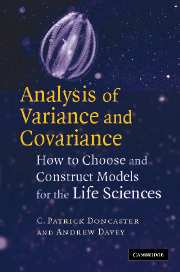Book contents
- Frontmatter
- Contents
- Preface
- Introduction to analysis of variance
- Introduction to model structures
- 1 One-factor designs
- 2 Nested designs
- 3 Fully replicated factorial designs
- 4 Randomised-block designs
- 5 Split-plot designs
- 6 Repeated-measures designs
- 7 Unreplicated designs
- Further Topics
- Choosing experimental designs
- How to request models in a statistics package
- Best practice in presentation of the design
- Troubleshooting problems during analysis
- Glossary
- References
- Index of all ANOVA models with up to three factors
- Index
- Categories of model
Introduction to model structures
Published online by Cambridge University Press: 13 November 2009
- Frontmatter
- Contents
- Preface
- Introduction to analysis of variance
- Introduction to model structures
- 1 One-factor designs
- 2 Nested designs
- 3 Fully replicated factorial designs
- 4 Randomised-block designs
- 5 Split-plot designs
- 6 Repeated-measures designs
- 7 Unreplicated designs
- Further Topics
- Choosing experimental designs
- How to request models in a statistics package
- Best practice in presentation of the design
- Troubleshooting problems during analysis
- Glossary
- References
- Index of all ANOVA models with up to three factors
- Index
- Categories of model
Summary
In the following Chapters 1 to 7, we will describe all common models with up to three treatment factors for seven principal classes of ANOVA design:
One-factor – replicate measures at each level of a single explanatory factor;
Nested – one factor nested in one or more other factors;
Factorial – fully replicated measures on two or more crossed factors;
Randomised blocks – repeated measures on spatial or temporal groups of sampling units;
Split plot – treatments applied at multiple spatial or temporal scales;
Repeated measures – subjects repeatedly measured or tested in temporal or spatial sequence;
Unreplicated factorial – a single measure per combination of two or more factors.
For each model we provide the following information:
The model equation;
The test hypothesis;
A table illustrating the allocation of factor levels to sampling units;
Illustrative examples;
Any special assumptions;
Guidance on analysis and interpretation;
Full analysis of variance tables showing all sources of variation, their associated degrees of freedom, components of variation estimated in the population, and appropriate error mean squares for the F-ratio denominator;
Options for pooling error mean square terms.
As an introduction to Chapters 1 to 7, we first describe the notation used, explain the layout of the allocation tables, present some worked examples and provide advice on identifying the appropriate statistical model.
Notation
Chapters 1 to 3 describe fully randomised and replicated designs. This means that each combination of levels of categorical factors (A, B, C) is assigned randomly to n sampling units (S′), which are assumed to be selected randomly and independently from the population of interest.
- Type
- Chapter
- Information
- Analysis of Variance and CovarianceHow to Choose and Construct Models for the Life Sciences, pp. 42 - 60Publisher: Cambridge University PressPrint publication year: 2007



